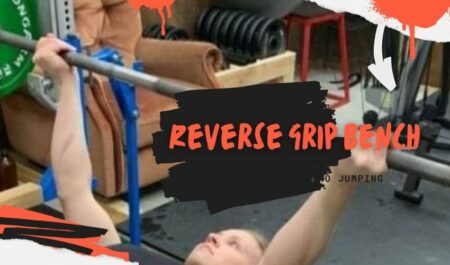The bench press is one of the most popular workouts for the chest and triceps because of its versatility. Many different grip configurations are available for the bench press, with different variations emphasizing slightly different muscle groups when compared to the standard bench press exercise. The reverse grip dumbbell bench press is a noteworthy alternative to the traditional bench press.
This bench press variation has not been studied as extensively as traditional bench press exercises; however, it does provide an alternative chest and tricep exercise for those who experience shoulder pain when performing traditional bench pressing or who are recovering from a shoulder injury, among other benefits.

Additionally, you can incorporate the reverse grip bench press into your strength and muscle-building program to provide a distinct stimulus when executing your chest workout, which will offer variation to your program. Including the appropriate form, muscles worked, advantages, precautions, and variations, this article covers all you need to know about the reverse grip bench press. It also includes a video demonstration.
Instructions On How To Perform The Reverse Grip Bench Press.
It is possible to perform the reverse grip bench press with the same equipment that is used for the standard press. Aside from an Olympic barbell and weight plates, you’ll also need a flat bench with J-hooks on a rack as well as safety pins if you can get them. Similarly to the standard bench press, you can use a power rack and flat bench, or any other similar setup that allows you to lie on your back on the bench and unrack the barbell to perform this exercise successfully.
Given that this will most likely be a new movement for you, begin by using only the bar and a very light weight for the first few weeks while you become familiar with the movement pattern.
Eventually, you should be able to lift bigger weights with the reverse grip bench press, but you will need to learn the appropriate technique first before adding more weight to the barbell.
It is important to note that there are several significant distinctions between the traditional and reverse grip bench presses, all of which revolve around the usage of a supinated grip rather than the pronated grip that is utilized in the standard bench press.
The following are the most significant differences in form:
- You can change your grip from pronated — or palms away — to palms facing you by switching your grip position.
- Thumbs turned outward to the side.
- Your hands are usually a little wider.
- Increased external rotation is maintained by your shoulders.
- When compared to the traditional bench press, the barbell offers a higher horizontal range of motion.
A Word About Proper Etiquette.
- In order to arch your back when performing the bench press, you must have significant scapular retraction as well as an overall arch in your spine that extends from the lower to the upper back.
- Using this style is common among powerlifters since it is acceptable in competition and shortens the overall distance required to establish chest contact with the barbell for a complete lift. As a result, the maximum liftable weight for a specific athlete appears to increase.
- It is possible that other fitness specialists will not endorse the idea of an arched back when bench pressing, particularly in the case of rookie or beginner weight lifters.
- The benefit of the arched back position for improving lifting performance has recently been called into question by new research.
- You should concentrate on the form that will best support the weight you’re lifting without creating pain if you’re new to the bench press. And, if you’re still not sure, see a skilled personal trainer for guidance.

To perform a proper reverse grip bench press, follow the techniques outlined below.
1. Determine The Height Of The Bench, The Safety Pin, And The Rack.
To begin, you must ensure that your computer is properly configured. You should adjust the hooks such that your initial grasp on the bar preserves a tiny bend in your elbow, which will allow you to rack and unrack your weights easily. This is true whether you’re using a regular flat bench with built-in J-hooks or a power rack and freestanding flat bench.
It is suggested that you use an experienced spotter. Using safety pins on your equipment is a must if you don’t have a spotter with you. This is especially important when performing the reverse grip bench press because the grasp is naturally less stable than it is when performing the regular bench press.
When you’re completely flat on the bench, you should position the safety pins so that they’re approximately the same height as your chest. Because you’ll be executing each repetition with a small arch in your back, this pin height will allow you to fully drop the bar on each rep while also preventing you from getting crushed under the bar in the event of a failure repetition.
2. Lie Down On The Bench And Grasp The Bench’s Edge With One Hand.
When laying on the bench, your position should be such that the bar is roughly over your nose, or even at eye level, depending on how high the bar is racked.
When you perform the exercise, the bar will not travel as far backward as it would otherwise; however, this configuration will still allow you to securely unrack the bar without slamming into the J-hooks during the repetitions.
With your palms facing you and your thumbs facing outward toward the ends of the barbell, you should begin with a grip that is wider than shoulder width apart. For the bar to sit firmly on your palm, you’ll need to flex your wrists slightly at the wrist joint. Because of the different grip angle, your hand grip will not be as tight on the pinky side of your fists as it would be on a regular bench.
3. Remove The Bar From The Rack And Return To The Starting Position.
Unrack the bar after you’ve established your grasp. Maintain your arms outstretched and raise the bar to the original position above your chest, just below the nipple line of your shoulders.
As you prepare for the set, engage your core and slightly arch your upper back to puff up your chest a little bit more. As a result, your chest should be slightly higher than the safety pin height of your bench press or power rack when you finish. Starting and ending in this position, each repetition is performed.
4. Carry Out The Required Repetitions.
Bending your elbows will allow you to lower the bar closer to your body from the starting position. Your upper arms will begin to descend toward the floor.
During the repeat, the bar should slide horizontally down your body as you lower it vertically, such that it ends up at approximately the level of your sternum and xiphoid process at the bottom of the repetition. Your wrists, elbows, and shoulders will be in a safe and biomechanically optimal position as a result of doing so.
The bar should be just above your sternum when you are finished. You can make slight contact with the bar with your body, but you should avoid bouncing the bar off of your sternum or rib cage. In your set, complete the amount of repetitions you specified as your goal.
5. Rack The Bar.
Continue to maintain your arms locked in the top position until you have completed your final repetition. Then, slowly lower the bar back into the J-hooks to rack it and complete the set.
When Compared To A Standard Bench Press, The Reverse Grip Bench Press Is More Difficult.
Aside from the differences in technique, the reverse grip bench press engages a different set of muscles. It also gives an additional variant for those who endure shoulder soreness when performing standard bench pressing, allowing them to increase their chest strength.
In terms of muscle activation, one study comparing the two bench press methods discovered higher activity of the biceps brachii and clavicular area of the pectoralis major when the bench press was performed with a reverse grip (as opposed to the traditional grip).
The same study also discovered that limiting the width of your grip in a standard bench press increased the emphasis on the triceps rather than the pectoralis major muscle group. When using a narrow-width reverse grip, this impact, on the other hand, was not observed.
When comparing the reverse grip bench press to the typical grip bench press, these findings imply that grip width does not have a statistically significant effect on performance. Begin with a grip that is broader than your shoulder width and adapt to your comfort level.
What is the weightlifter’s shoulder?
In terms of injuries sustained while bench pressing, a 2016 review found that bone disintegration at the distal clavicle, also known as the collarbone, and a widening of the acromioclavicular joint, often known as “weightlifter’s shoulder,” were both common injuries sustained while bench pressing.
According to the findings of the analysis, shoulder dislocations were another prevalent injury encountered when performing classic flat benching pressing. The reverse grip bench press was recommended as a modification to the bench press in order to prevent the strains that cause the previously described shoulder ailments that are linked with bench pressing.
When opposed to typical grip bench press variations, there has been less research on the reverse grip bench press aside from these two studies mentioned above.
In spite of this, the reverse grip bench press is a potential alternate chest workout if you are prone to shoulder pain when bench pressing or are recuperating from an injury related to bench pressing.
The Reverse Grip Bench Press Is A Great Way To Work Your Muscles.
The following muscles are engaged in the reverse grip bench press;
- The clavicle of the pectoralis major muscle (upper portion of the chest)
- Biceps brachii
- Triceps brachii
- Anterior deltoid (the front shoulder muscle)
The Advantages Of Using A Reverse Grip Bench Press.
As previously stated, the reverse grip bench press can be a safer option to the regular bench press for people who have shoulder ailments or shoulder pain.
The reverse grip bench press has a number of extra advantages, including the ability to add more variation to your exercise program. Training the chest and triceps with horizontal pressing motions, in particular, is essential for developing a muscular upper body, particularly for muscle building.
The pronated grip used in conventional bench pressing, as well as a neutral grip used occasionally with dumbbells or a chest press machine, are used in the majority of traditional chest exercises.
The reverse grip provides your muscles with a fresh type of stimuli. The variation in movement activates fibers in a little different way, which can assist round out the growth of your muscular development.
More importantly, incorporating more diversity into your program lowers your chance of overuse injuries and prevents your body from becoming too acclimated to a single activity, which might potentially stop your progress.
Finally, mixing up your workouts reduces the likelihood of becoming bored with the same program over an extended period of time. As a result of the long-term commitment required for strength and muscular development, this is essential for ensuring that you remain committed to strength training for the long haul.
Precautions Should Be Taken When Performing The Reverse Grip Bench Press.
Despite the fact that the reverse grip bench press is a relatively safe exercise when executed correctly, there are a few safety precautions to be aware of. When opposed to the typical bench press, the most significant disadvantage is that the grip is less mechanically secure. In some cases, this can increase your chances of losing the barbell or having it slip from your grasp while doing a repetition.
The use of a trained spotter or safety pins greatly reduces this risk to a significant extent. It is possible to ask for assistance from your spotter if the bar begins to slip, and the safety pins will grab the bar and prevent it from crushing you.
In addition, you can reduce the risk of slipping by practicing the movement with light weights or just the bar until you have mastered the range of motion and grip dynamics. In general, this is sound advice when performing new exercises, and it is essential for avoiding injuries when learning new movement patterns.
In addition, if your gym allows it, applying weightlifting chalk to your hands can help you maintain a better grip on the barbell. The movement’s uniqueness should also be taken into account, as previously stated. Specificity is defined as the degree to which a given exercise translates into athletic performance.
For example, benching with a standard, pronated grip is required in the sport of powerlifting.
Although powerlifters may benefit from integrating some reverse grip benching in their warmup or rehabilitation program, the majority of their efforts should be focused on increasing performance on the movement they use in competition, which in this case is the traditional bench press.
Resistance exercises should be assigned with care in other sports, as well, because coaches must carefully evaluate the dynamics of the sport while assigning them.
Given the limited time available to athletes for training and recovery, selecting activities that are appropriate to their activity becomes particularly critical for this population.
Aside from these restrictions, the reverse grip bench press is a safe and effective exercise that is well worth trying for most general fitness and muscle-building reasons, including weight loss.
Bench Press Variations With A Reverse Grip.
The reverse grip bench press can be performed in a variety of ways. To put it another way, any exercise that involves horizontal pressing with the reverse grip is essentially a variant on the reverse grip bench press. Some prominent instances of reverse grip bench press variations are shown in the following section.
Bench Press With An Inclined Reverse Grip.
In the inclined reverse grip bench press, you will use a bench that is 30–45 degrees incline to do the exercise. Because of this, the pressing angle is different when compared to when using a flat bench.
In all other aspects, form cues are the same as they are for deadlifts: use the reverse grip, use a spotter or safety pins, and make sure the bar begins above the upper chest and lowers toward the sternum, creating an angled bar path with some horizontal movement.
With A Reverse Grip Dumbbell Press.
Using dumbbells to perform horizontal presses raises the stabilizing needs of the exercise while also ensuring equal load on both arms and a more natural movement path throughout the motion.
Dumbbell presses can be performed with a reverse grip, just as you would with a regular pressing position. Always start with small weights, especially when using dumbbells, because of the instability that might occur when using them. You can execute reverse grip dumbbell press on a flat, incline, or decline bench, depending on your preference.
You can also do them from the floor while lying on your back, but this will decrease the depth to which you can lower because your upper arms will touch the floor when you do this.
Chest Press With A Reverse Grip Machine.
Chest press machines, which are commonly seen in commercial gyms and provide a fixed range of motion for exercising the chest, are quite popular among fitness enthusiasts.
These machines are excellent for elderly folks and rehabilitation patients, as well as for increasing the amount of chest volume you get from your exercises.
They can be set up in an upright sitting posture with a horizontal pressing motion, or they can be fixed to a regular flat or incline bench configuration.
To use the reverse grip variation, simply execute the chest press exercise using a supinated reverse grip instead of the traditional grip. Because there is virtually no risk of dropping the weight on oneself if your grasp slips, the machines are a rather safe approach to master exercises with a reverse grip.
The bottom Line
The reverse grip bench press is a chest exercise that uses a supinated grip, which means that your palms face you and your thumbs point outward, as opposed to the traditional grip.
As well as providing benefits in terms of shoulder injury prevention and recovery, this exercise also involves slightly diverse muscle activation, making it a wonderful way to add variation to your workout routine.
The exercise can be performed by both recreational lifters and athletes of all levels of ability. Athletes that are forced to execute traditional grip bench presses, such as powerlifters, should think about limiting their use of reverse grip bench pressing.
When utilizing a reverse grip posture, safety concerns are mostly focused on the diminished grip stability that results. It is possible to lessen this risk by employing a spotter, safety pins, and chalk.
Additionally, when learning a new movement for the first time, start with light weights to get a feel for it. The reverse grip bench pressing movement can be modified to include virtually any horizontal pressing movement that makes use of the supinated reverse grip.
The reverse grip bench press is a great version of the traditional chest exercise that you should incorporate into your next chest workout to get the benefits of it.
